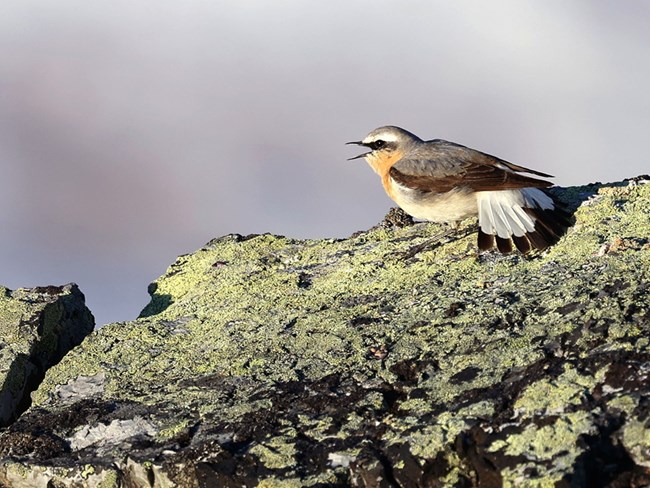Last updated: November 13, 2023
Article
Bird responses to subarctic tree and shrub expansion

NPS/Jared Hughey
Amplified climate warming is inducing cascading impacts in boreal-tundra regions including the expansion of conifers and deciduous shrubs. We assessed the impacts of changes in shrub and conifer cover on the relative abundance of 12 passerine species in Denali National Park from 1995-2020. Below-treeline conifer infilling appears to be pushing the elevational distributions of shrub-adapted passerines upslope rather than these species following the pull of modest shrub expansion above treeline, as previously assumed. Overall, our findings illustrate the need for explicitly accommodating heterogeneity in habitat change at small spatial scales to properly view the distributional response, particularly when habitat change is concentrated at ecotones.
Tree and shrub expansion at treeline drive contrasting responses in a subarctic passerine community
Abstract
-
Inferences about the mechanisms of distributional change are often made from simple assessments of variation in the geographical positions of populations. However, direct assessments of species' responses to local habitat change may be necessary for proper understanding of the drivers of distributional dynamics.
-
Amplified climate warming is inducing cascading impacts in boreal-tundra regions including the expansion of conifers and deciduous shrubs (shrubs). In Denali National Park (Denali), Alaska, passerine birds are exhibiting rapid upslope shifts in distribution but the relative roles of conifer and shrub (woody vegetation) expansion in driving these shifts are unknown. Without directly assessing passerine-vegetation dynamics, the assumption has been that the observed upslope shifts are indicative of shrub-adapted passerines tracking the upslope expansion of shrubs. Here, we jointly investigate the processes of conifer and shrub expansion and their relationship to changes in passerine abundance in Denali.
-
We used a remotely sensed vegetation cover timeseries (1985–2020) to assess the topographic and edaphic correlates of conifer and shrub expansion. We then assessed the impacts of changes in shrub and conifer cover on the relative abundance of 12 passerine species (1995–2020).
-
Shrub and conifer colonization rates were highest at intermediate elevations near treeline. However, forest- and shrub-adapted passerines differed in terms of the location in which their response was concentrated relative to treeline. The population growth rates of forest-adapted passerines exhibited stronger effects of woody vegetation expansion at sites that were initially above treeline (IAT). In contrast, the population growth rates of shrub-adapted passerines exhibited the negative effects of conifer expansion together with the positive effects of shrub expansion at initially below treeline sites. However, they showed a weak response to woody vegetation expansion at sites that were IAT.
-
Below treeline conifer infilling appears to be pushing the elevational distributions of shrub-adapted passerines upslope rather than these species following the pull of modest shrub expansion above treeline, as previously assumed.
-
Overall, our findings illustrate the need for explicitly accommodating heterogeneity in habitat change at small spatial scales to properly view the distributional response, particularly when habitat change is concentrated at ecotones.
Mizel, J. D., J. H. Schmidt, C. A. Roland, and C. L. McIntyre. 2023. Tree and shrub expansion at treeline drive contrasting responses in a subarctic passerine community. Journal of Animal Ecology 92(6): 1256-1266.
